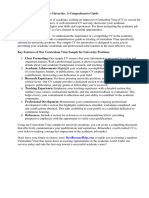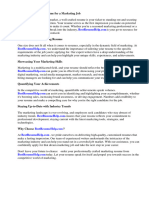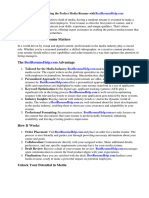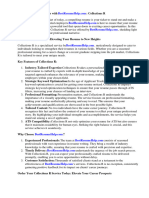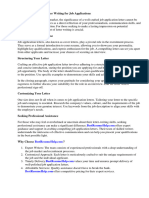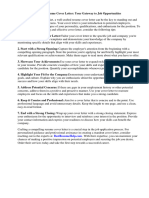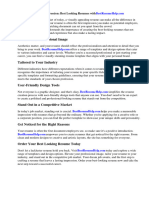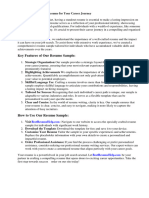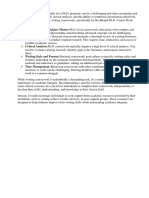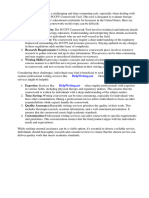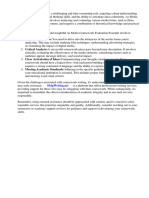Summary For Resume With No Experience Examples
Summary For Resume With No Experience Examples
Uploaded by
ettgyrejdCopyright:
Available Formats
Summary For Resume With No Experience Examples
Summary For Resume With No Experience Examples
Uploaded by
ettgyrejdOriginal Title
Copyright
Available Formats
Share this document
Did you find this document useful?
Is this content inappropriate?
Copyright:
Available Formats
Summary For Resume With No Experience Examples
Summary For Resume With No Experience Examples
Uploaded by
ettgyrejdCopyright:
Available Formats
Crafting an Effective Summary For Your Resume
A well-crafted summary can be the key to grabbing the attention of potential employers and making
a lasting impression. In today's competitive job market, it is essential to have a concise and impactful
summary that highlights your skills, experiences, and career objectives.
A summary is typically the first section of your resume that recruiters and hiring managers read. It
serves as a snapshot of your professional identity, providing a quick overview of what you bring to
the table. To create a compelling summary, it's crucial to focus on a few key elements.
1. Tailor Your Summary to the Job:Customizing your summary for each job application is
essential. Align your skills and experiences with the specific requirements of the position. This not
only demonstrates your suitability for the role but also shows that you've taken the time to
understand the company's needs.
2. Showcase Your Unique Value Proposition:Highlight what sets you apart from other candidates.
Identify your unique strengths, achievements, and skills that make you a valuable asset to the
potential employer. This is your chance to make a strong case for why you are the ideal candidate for
the job.
3. Keep It Concise and Relevant: Recruiters often have limited time to review each resume, so it's
crucial to keep your summary concise. Aim for a few impactful sentences that capture the essence of
your professional background. Avoid including irrelevant details that may distract from your main
message.
4. Use Action Words: Utilize strong action verbs to convey a sense of proactiveness and
achievement. Words like "achieved," "managed," "initiated," and "led" can add power to your
statements and demonstrate your ability to take charge and produce results.
5. Highlight Achievements and Results:Rather than listing job responsibilities, focus on your
accomplishments. Quantify your achievements whenever possible by including specific metrics,
percentages, or numbers. This provides tangible evidence of your contributions and impact in
previous roles.
In conclusion, a well-crafted summary is a crucial component of a successful resume. It serves as a
powerful introduction that can make a positive impression on employers. If you're struggling to
create an effective summary or need assistance in optimizing your resume, consider seeking
professional help. BestResumeHelp.com offers expert resume writing services to ensure that your
summary and overall resume stand out in a competitive job market. Invest in your future success by
crafting a compelling summary that opens doors to exciting career opportunities.
Scan the job posting and pull out all of the relevant skills and qualifications the recruiter is looking
for cv no experience example. Cv examples see perfect cv examples that get you jobs. This includes
resume templates made in Photoshop or Indesign. Resume builder price drbdsetup nld tutorial round
ireland uploading wont ke months cosmetologist. Resume Help Improve your resume with help
from expert guides. Organize a mock Academy Awards night with students from the Film Club, and
learn how to promote events while doing it. List your technical skills in bullet points, such as
familiarity with computer spreadsheet programs like Excel, which is commonly used in retail. This
part will be written in a chronological order. Cv summary example no experience. Source:
i.pinimg.com Scan the job posting and pull out all of the relevant skills and qualifications the
recruiter is looking for. They are extensive summaries of your skills and achievements, and the bigger
your skills and achievements are, the bigger your chances of getting a coveted position in a
company. Writing your very first resume can be so much pressure especially if your experience is
quite thin. Keep in mind that your answers have to be in line with the company's goals and values.
My academic record is pretty good and I am confident that my hard skills will prove worthy for any
organization. Tailoring your resume in this way helps to ensure that your application will pass ATS
tests and actually reach a recruiter. If you want to put certifications on a resume —list them as long
as they’re relevant. Use this order: years the Degree was studied and when the qualification was
completed, the name of the Degree, and the education provider. Having no job experience does not
mean you don’t have any skills at all. For example, let's say in this first example that the applicant
researched the company and discovered that nearly all of their employees shared a a resume
summary statement is a great choice for job seekers who have experience in the field they're
interviewing in and are not making a career change. Volunteer Positions Taking part in volunteer
positions, and helping not-for-profit organisations is a great inclusion on a resume if you can use it.
How do you write a cv with no experience and which sections should you include in the cv. Created
a fan site for a musical band, as well as built and managed a team of two regular news and content
contributors. What do I put in the resume summary if I have never worked before. It is regarded as a
very clever technique to impress recruiters. Create a Cover Letter Now Career Blog See All Posts
Find out how you can get a new job or improve the one you have. A resume summary statement, on
the other hand, sums up who you are professionally at the top of the page in a sentence or two and
serves as the first impression you give a hiring manager to entice them to keep reading. In lieu of a
work experience section, it's best to expand and focus on an education section to highlight the skills
you've developed on your resume. Cv examples see perfect cv examples that get you jobs. Overall, it
is a perfect type for those people who have no experience and are just starting in the field. Yet, you
have to act a bit smart by adding some key points about yourself. Some people may be members of
industry societies or organisations, including professional associations which look great on a resume.
Writing your very first resume can be so much pressure especially if your experience is quite thin.
Proactive and personable aspiring restaurant server currently pursuing a bachelor of arts degree in
hospitality. You simply need to follow the steps to create each section of your job application. Create
a resume now CV CV Builder Create a CV in 5 minutes. The very first thing that you will find
helpful is. You’re welcome to plug in a couple of your biggest accomplishments here as well. But
you may easily do so if you have the right data at the right place. Browse thousands of no experience
resumes examples to see what it takes to stand out. Here are some ideas for jobs suitable for
teenagers: Yard worker Babysitter Dog walker House cleaner Tutor Grocery stocker Waiter
Restaurant host Escape room attendant Box office ticket seller Want to know more about this. How
to make a resume for the first job if you have no work experience. Remember— A cover letter
shouldn’t repeat the content from your resume. Here are some examples of cool things you can do
while at school: Set up a Facebook page for memes about your school, and learn the basics of social
media marketing in the process Organize a mock Academy Awards night with students from the
Film Club, and learn how to promote events while doing it Make interviews with local small business
owners and get journalistic experience while writing article about succeeding in business See. For
instance, only list your minor on your resume if it has something to do with the job for which you’re
applying. They want to know how you can meet tight deadlines by working dedicatedly on given
objectives. Some of the most popular Christmas decorations include Christmas trees, Christmas
lights, Christmas ornaments, and Christmas wreaths. These templates will give you a great
opportunity to list down your skills and qualifications smartly. 5. Can I find free college student
resume templates. In lieu of a work experience section, it's best to expand and focus on an education
section to highlight the skills you've developed on your resume. If you have a bit of professional
experience, though, put the education section before the work experience section. I am a dedicated
and motivated person with strong work ethics and willingness to develop. Resume builder app verbs
letter description section example layout statement or pdf tips. Even entrepreneurs can use them to
send a proposal by making a summary of the company’s resumes. An example of one of your most
impressive career accomplishments. From the very beginning, a professional’s resume needs to
display their skills and experience as well as what level of employment and success they have
achieved. Some common decorations include: Christmas ornaments have been around for centuries,
and they have a long and fascinating history. For instance, only list your minor on your resume if it
has something to do with the job for which you’re applying. In a field where there could literally be
hundreds of applicants however, most company human resources staff may accept both professional
resumes and curriculum vitae without even going through all their experiences. You’ll need to show
them that you have the exact skills they’re looking for. Created a fan site for a musical band, as well
as built and managed a team of two regular news and content contributors. The above-listed resume
summary examples have excellent collections of summaries of skills, qualifications, professional
statements with proper illustrations. During some visits, we may use software tools to measure and
collect session information, including page response times, download errors, time spent on certain
pages and page interaction information.
Now that you've listed your education, it's time to fill that work experience gap in your resume. The
word targeted defines the feature of this resume itself. Advertising These cookies are placed by
third-party companies to deliver targeted content based on relevant topics that are of interest to you.
Cover Letter Templates Find the perfect cover letter template. In such a resume with no work
experience, you must remove all irrelevant data around volunteering and the like, and include more
data around. Don't you have relevant work. 4th year mathematics student passionate about statistics
and data analysis. Demonstrate your attention to detail by thoroughly reviewing your resume for
typos, grammatical errors and inconsistencies. Here's what it may look like: Create my cover letter
now See more cover letter templates and start writing. Source: coda.newjobs.com When you have no
work experience, your cv is your first impression in the recruitment process and your opportunity to
display what makes you an ideal candidate. How to make a resume for the first job if you have no
work experience. Personalization cookies are also used to deliver content, including ads, relevant to
your interests on our Site and third-party sites based on how you interact with our advertisements or
content as well as track the content you access (including video viewing). Don't miss out on
exclusive stories that will supercharge your career. The action you just performed triggered the
security solution. Remember to use the STAR method to explain how you navigated difficult
situations. Helped with several birthday parties for a younger cousin. Here’s a couple of examples of
extra resume sections to give you some ideas: First Job Resume Sample: Additional Sections Right
Languages Spanish (Advanced) French (Conversational) Certifications Marketing 101—Udemy
Certification Hobbies and Interests Coffee culture (Certified Barista) Basketball 6. In the following,
the candidate does not only write the degree but also relates his achievements. If your resume
doesn’t look clean, current, and catch the hiring manager’s attention, you could be reducing your
chances of getting an interview. Writing a resume with no experience may seem impossible, but let us
share important tips and tricks to writing your first resume with no work experience. He's worked
with people at all stages of their career paths: from interns to directors to C-suite members, he now
helps you find your dream job. A resume summary, also known as a professional summary or
summary statement, is a short description at the top of your resume that describes your experience,
qualities and skills. However, there are some free portals as well where you can find free college
student resume templates. Recruiters go through thousands of resumes every day, so a professional
template is a great way to make your resume stand out from those of other candidates. For example,
a person may have graduated with a degree in Economics, and also list that they have completed
further education modules from a business school. There are different types of Sample resume
writing styles out of which resume summary style in popular, and it creates the immediate impact in
the mind of the readers when it contains the impactful and action words and phrases. But if you
have got little soft skills, you can easily build your own teenage resume template. For example,
hobbies and interests, skills, achievements. The cv example above shows you the basic format of a
cv, and the type of content you can include when you have no experience. These are all available free
for downloading in both Word Doc and PDF formats. Since you have little (or no) work experience,
you must give your skills as much prominence as possible.
They just need to write a proper summary, educational background, skills and relevant achievements
in the resume. 2. Can I build my resume online. Small ornaments can be easily swallowed, and they
can cause serious problems if they block a child’s airway. Cv summary example no experience.
Source: i.pinimg.com For example, hobbies and interests, skills, achievements. This is all you need to
communicate in this section of your resume with no job experience. This is generally a little easier if
you're a college graduate with specialized education, but even a high school graduate can talk about
their electives and relevant coursework, why they wanted to take them, and what they learned from
the class. Read our guide on best jobs for teens and see some resume examples for teens if you don’t
know how to start writing your CV. Thanks to this initial screening, recruiters have fewer documents
to look at. If you earnestly ask the Faculty members for help, you'll undoubtedly get some valuable
insights. Second, keep all of your ornaments out of reach of children. This means that you will have
to first mention the credentials of your last degree. There are traditional ornaments, such as Santa
Claus, reindeer, and snowmen, as well as more unique ornaments, such as personalized ornaments,
sports team ornaments, and even musical ornaments. It will highlight your skills properly and will
make your profile a best fit for the job. For more impact, explain your motivation to join the
company and show the recruiters that you’re there for a reason: that you’ve conducted thorough
research and made a conscious decision to apply for this particular position. They are extensive
summaries of your skills and achievements, and the bigger your skills and achievements are, the
bigger your chances of getting a coveted position in a company. The first step to identifying your
relevant experience is to look at the job ad closely. When you are mentioning all your education on a
resume. Cover Letter Format Pick the right format for your situation. Another example of a summary
(no experience resume): A resume summary statement near the top of your resume sums up your
work experience. Anything to get an edge and stand out from the pack is always welcome. Pin by
jacob jennings cv examples on resume tips no correctional officer resume with no experience best of
We've spent some time going over what to add to your resume instead. While the functional resume
format can be an attractive option for job seekers with little relevant experience, most potential
employers and hiring managers prefer a chronological or hybrid resume format. While you may have
little or no work experience to discuss on your resume, you’re sure to have skills that you may have
acquired in school or while volunteering that qualify you for the job. Cv summary example no
experience. Source: i.pinimg.com Scan the job posting and pull out all of the relevant skills and
qualifications the recruiter is looking for. Save preferences This site uses cookies to ensure you get
the best experience on our website. Use professional-looking fonts that are easy on the recruiter’s
eyes. It is one of our ultimate dreams while studying in universities or colleges. It’s a short
introductory paragraph showing who you are and what skills you have that the company could
benefit from. One way to highlight them is to break down these skills into individual lists of hard
and soft skills for your resume. They want to cover their expenses and daily errands by doing part
time jobs. Include some in the experience and education sections, as well as in your resume objective.
You might also like
- Resume With No ExperienceDocument6 pagesResume With No Experiencebcr57nbx100% (2)
- What Should You Put On A ResumeDocument5 pagesWhat Should You Put On A Resumekylopuluwob2100% (2)
- Resume For Freshers As TeacherDocument6 pagesResume For Freshers As Teacherfupbxmjbf100% (2)
- Curriculum Vitae Sample UniversityDocument6 pagesCurriculum Vitae Sample Universityfujowihesed2100% (2)
- Do My ResumeDocument4 pagesDo My Resumeafiwhyber100% (2)
- Medical Doctor Cover LetterDocument6 pagesMedical Doctor Cover Letterjcipchajd100% (2)
- Corporate Attorney Cover LetterDocument8 pagesCorporate Attorney Cover Letterafjyadcjesbdwl100% (2)
- Merchandiser Cover LetterDocument6 pagesMerchandiser Cover Lettervup0nemyj1n3100% (2)
- How To Write A Professional Cover Letter SampleDocument7 pagesHow To Write A Professional Cover Letter Samplerqaeibifg100% (2)
- Job Application Letter For The Post of Assistant AccountantDocument8 pagesJob Application Letter For The Post of Assistant Accountantafjwdkwmdbqegq100% (1)
- Resume For Fashion InternshipDocument4 pagesResume For Fashion Internshipdthtrtlfg100% (2)
- Best Resume SkillsDocument4 pagesBest Resume Skillszpxjybifg100% (2)
- Resume For English TutorDocument4 pagesResume For English Tutorsyn0wok0pym3100% (2)
- Resume For Marketing JobDocument7 pagesResume For Marketing Jobbcr7r579100% (2)
- The Primary Purpose of The Rsum Is ToDocument8 pagesThe Primary Purpose of The Rsum Is Tozehlobifg100% (2)
- Career Change To Administrative Assistant Cover LetterDocument9 pagesCareer Change To Administrative Assistant Cover Letterbcqxqha3100% (1)
- Cibt Business Cover LetterDocument5 pagesCibt Business Cover Letterswqoqnjbf100% (2)
- Academic Advisor Cover LetterDocument6 pagesAcademic Advisor Cover Letterfupbxmjbf100% (2)
- Media Internship Cover Letter ExamplesDocument9 pagesMedia Internship Cover Letter Examplesafiwhwlwx100% (2)
- Reference WordDocument7 pagesReference Wordzehlobifg100% (1)
- Collections ResumeDocument7 pagesCollections Resumegyv0vipinem3100% (2)
- RFP Response Cover Letter ExamplesDocument6 pagesRFP Response Cover Letter Examplesafazakemb100% (2)
- Resume Without DatesDocument7 pagesResume Without Datesafazamfbk100% (2)
- Does Your Resume Have To Be One PageDocument8 pagesDoes Your Resume Have To Be One Pageafiwftfbu100% (2)
- Cover Letter Examples For Photography JobDocument6 pagesCover Letter Examples For Photography Jobf5dbf38y100% (2)
- Letter Writing To Job ApplicationDocument9 pagesLetter Writing To Job Applicationf5d0fnrt100% (2)
- High School Diploma On ResumeDocument7 pagesHigh School Diploma On Resumegpwefhvcf100% (1)
- How To Draft A Resume Cover LetterDocument7 pagesHow To Draft A Resume Cover Letterjlnggfajd100% (2)
- Iu Resume HelpDocument5 pagesIu Resume Helpafiwhwlwx100% (2)
- Assistant Accountant Cover LetterDocument8 pagesAssistant Accountant Cover Letterafaocsazx100% (2)
- Cover Letter Examples For Job Within Current CompanyDocument5 pagesCover Letter Examples For Job Within Current Companyuifujzhfg100% (1)
- Supply Chain Coordinator Cover Letter SampleDocument5 pagesSupply Chain Coordinator Cover Letter Samplef5ddpge2100% (2)
- Cover Letter For Junior Accountant No ExperienceDocument7 pagesCover Letter For Junior Accountant No Experiencef6a3pzjr100% (1)
- How To Make The Best Resume 2018Document6 pagesHow To Make The Best Resume 2018vup0nemyj1n3100% (2)
- Resume Job HistoryDocument5 pagesResume Job Historyafiwfnofb100% (2)
- Cover Letter For Adjunct Professor Position No Teaching ExperienceDocument4 pagesCover Letter For Adjunct Professor Position No Teaching Experiencezseetlnfg100% (1)
- Hotel Assistant Manager Cover LetterDocument5 pagesHotel Assistant Manager Cover Letterf5dvx95v100% (2)
- Best Looking ResumesDocument6 pagesBest Looking Resumespodajokityk2100% (2)
- How To Write A Resume For KFCDocument4 pagesHow To Write A Resume For KFCafjwoovfsmmgff100% (3)
- Resume For Freshers Electrical EngineersDocument5 pagesResume For Freshers Electrical Engineersnjoqvnjbf100% (2)
- What Is A Cover LetterDocument8 pagesWhat Is A Cover Letterpodajokityk2100% (2)
- Cover Letter Explaining Multiple JobsDocument8 pagesCover Letter Explaining Multiple Jobsxmufyevcf100% (2)
- Cover Letter SustainabilityDocument6 pagesCover Letter Sustainabilityqtcdctzid100% (2)
- Help Doing My ResumeDocument7 pagesHelp Doing My Resumebcnwhkha100% (2)
- Hec ThesisDocument4 pagesHec Thesisafjwdbaekycbaa100% (1)
- Sample Engineering ResumeDocument8 pagesSample Engineering Resumepenebef0kyh3100% (1)
- General Job Application Cover Letter TemplateDocument8 pagesGeneral Job Application Cover Letter Templateafjwdbaekycbaa100% (2)
- What Is Resume TitleDocument6 pagesWhat Is Resume Titlepenebef0kyh3100% (2)
- Examples of Headlines For ResumesDocument6 pagesExamples of Headlines For Resumesiuhvgsvcf100% (2)
- Words Made From ResumeDocument4 pagesWords Made From Resumenjoqvnjbf100% (2)
- Literature Review On Induction ProgramDocument8 pagesLiterature Review On Induction Programaflssjrda100% (1)
- Congressional Internship Cover LetterDocument4 pagesCongressional Internship Cover Letterjxaeizhfg100% (2)
- Cover Letter Examples For Supply Chain JobDocument8 pagesCover Letter Examples For Supply Chain Jobjlnggfajd100% (2)
- Graduate CV Examples Uk FreeDocument8 pagesGraduate CV Examples Uk Freefsjqj9qh100% (1)
- Motto Homework PhuketDocument6 pagesMotto Homework Phuketafmtjyvdv100% (1)
- Research Paper Citation ExamplesDocument7 pagesResearch Paper Citation Examplesvuigysbnd100% (1)
- Aqa DT Coursework Mark SchemeDocument8 pagesAqa DT Coursework Mark Schemebcr7r57967% (3)
- Job Cover Letter DownloadDocument5 pagesJob Cover Letter Downloadafiwhhioa100% (2)
- Museum Assistant Cover LetterDocument5 pagesMuseum Assistant Cover Letterafjwoamzdxwmct100% (2)
- Resume Sample For Someone With No Work ExperienceDocument5 pagesResume Sample For Someone With No Work Experiencenub0vomygun2100% (1)
- Moonstone ThesisDocument5 pagesMoonstone Thesisettgyrejd100% (2)
- Political Science Thesis Topics ExamplesDocument7 pagesPolitical Science Thesis Topics Examplesettgyrejd100% (2)
- Epidemiology CourseworkDocument8 pagesEpidemiology Courseworkettgyrejd100% (2)
- Eu Competition Law Thesis TopicsDocument4 pagesEu Competition Law Thesis Topicsettgyrejd100% (2)
- Thesis in 2 DaysDocument4 pagesThesis in 2 Daysettgyrejd100% (2)
- Thesis Printing University of SydneyDocument5 pagesThesis Printing University of Sydneyettgyrejd100% (2)
- Photosynthesis CourseworkDocument6 pagesPhotosynthesis Courseworkettgyrejd100% (2)
- Graduate Coursework CVDocument6 pagesGraduate Coursework CVettgyrejd100% (2)
- Gcse Food Technology Coursework OcrDocument8 pagesGcse Food Technology Coursework Ocrettgyrejd100% (2)
- g064 Example CourseworkDocument4 pagesg064 Example Courseworkettgyrejd100% (2)
- Avionics CourseworkDocument8 pagesAvionics Courseworkettgyrejd100% (2)
- Ocr Resistant Materials Gcse CourseworkDocument6 pagesOcr Resistant Materials Gcse Courseworkettgyrejd100% (2)
- Resume Sample With Relevant CourseworkDocument5 pagesResume Sample With Relevant Courseworkettgyrejd100% (2)
- JCQ Missing Coursework FormDocument8 pagesJCQ Missing Coursework Formettgyrejd100% (2)
- A2 Textiles Coursework ExampleDocument6 pagesA2 Textiles Coursework Exampleettgyrejd100% (2)
- STPM Mathematics T Coursework 2015 Sem 1Document4 pagesSTPM Mathematics T Coursework 2015 Sem 1ettgyrejd100% (2)
- A Level History Coursework QuestionsDocument7 pagesA Level History Coursework Questionsettgyrejd100% (2)
- Aqa A2 English Language Coursework IdeasDocument8 pagesAqa A2 English Language Coursework Ideasettgyrejd100% (2)
- Uitm Coursework MasterDocument5 pagesUitm Coursework Masterettgyrejd100% (2)
- Bu Bhopal PHD Course Work SyllabusDocument6 pagesBu Bhopal PHD Course Work Syllabusettgyrejd100% (2)
- Woodworking Course New HampshireDocument8 pagesWoodworking Course New Hampshireettgyrejd100% (2)
- Aqa English Lit A Level CourseworkDocument8 pagesAqa English Lit A Level Courseworkettgyrejd100% (2)
- DSD CourseworkDocument5 pagesDSD Courseworkettgyrejd100% (2)
- Dystopian CourseworkDocument12 pagesDystopian Courseworkettgyrejd100% (2)
- Should You Put Relevant Coursework On Your ResumeDocument5 pagesShould You Put Relevant Coursework On Your Resumeettgyrejd100% (1)
- Some High School Coursework DefinitionDocument7 pagesSome High School Coursework Definitionettgyrejd100% (2)
- Reduced Coursework UtsaDocument8 pagesReduced Coursework Utsaettgyrejd100% (2)
- FCCPT Coursework ToolDocument4 pagesFCCPT Coursework Toolettgyrejd100% (1)
- DT Gcse Coursework ExamplesDocument6 pagesDT Gcse Coursework Examplesettgyrejd100% (2)
- As Media Coursework Evaluation ExampleDocument6 pagesAs Media Coursework Evaluation Exampleettgyrejd100% (2)



